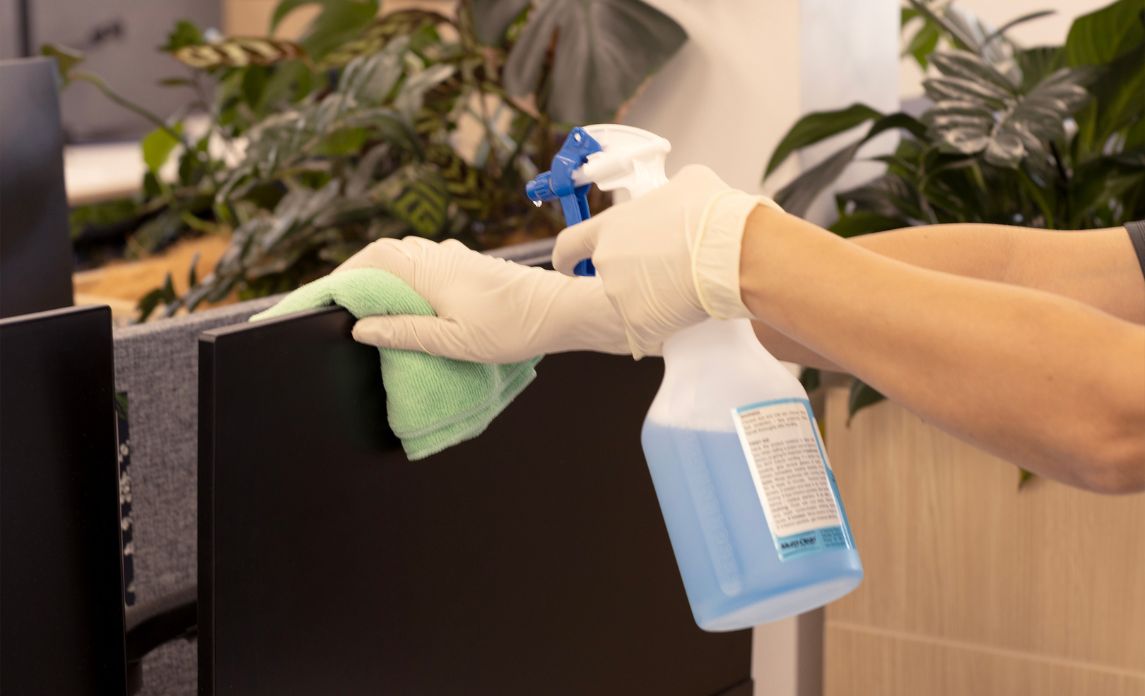In today's fast-paced office environments, electronic devices are the backbone of productivity and communication. From computers and printers to telephones and tablets, these devices play a crucial role in daily operations.
However, amidst the hustle and bustle of the workplace, it's easy for these electronics to accumulate dust, dirt, and grime, leading to hygiene concerns and potential performance issues. Thus, it’s important to make time to clean your office electronics.
Cleaning Office Electronics: Hygiene and Beyond
Hygiene is among the foremost reasons for cleaning office electronics. This is particularly true for shared equipment, like telephones and fax machines. The more people touch and use these devices, the more they can harbour harmful germs and bacteria. Ultimately, regularly cleaning these office essentials help prevent the spread of illnesses and promote a healthier work environment.
Secondly, proper cleaning helps extend the lifespan of electronic equipment. Dust and debris can also hinder the performance of devices by causing overheating and reduced functionality. Thus, by implementing a regular cleaning routine, businesses can mitigate the risk of damage and ensure that their electronic assets operate efficiently for years. This also lowers costs associated with repairs, professional servicing, and replacements.
How to Clean Your Office Electronics
As you can see, cleaning office electronics is key to health, safety, efficiency, and savings. Therefore, it’s something that you should take seriously. Below are some key tips for cleaning different types of office electronics, which professional cleaning companies like Crewcare also use:
Keyboards and Mice
The first step to cleaning electronic peripherals is to turn off the main device (the computer) and then disconnect each accessory. For keyboards and mice, a can of compressed air is a good starting point to remove dust and debris from between the keys and crevices.
Then, wipe the surfaces with a soft, microfiber cloth dampened with a small amount of isopropyl alcohol or a mild cleaning solution. For stubborn stains, use a cotton swab dipped in isopropyl alcohol to gently clean the affected areas.
For keyboards in particular, if the specific keyboard model allows it, remove individual keys and soak them in warm soapy water; then, clean the board with compressed air or cotton swabs. After washing and thoroughly drying each key, carefully reattach them to the board.
Computer Monitors
After turning off and unplugging the monitor, use a microfiber cloth to gently wipe the screen in a circular motion to remove dust and smudges. If there are particularly patches to clean, you can lightly dampen the cloth with water or a screen-cleaning solution. Avoid using harsh chemicals or ammonia-based cleaners, as they can damage the screen. Fianlly, dry the screen thoroughly with a separate clean microfiber cloth.
Telephones
If applicable, unplug the telephone from the power source. Then, use a soft, damp cloth to wipe the surface of the phone; pay extra attention to the handset and keypad, as well as the mouthpiece. If the phone has removable parts (such as the handset or keypad), clean them separately with a mild soap solution and water. Dry the phone thoroughly with a clean, dry cloth before reconnecting it.
Printers and Copiers
Printers and copiers are more complicated to clean than other office electronics. Make sure to refer to the manufacturer's instructions for cleaning and maintenance, as procedures may vary depending on the model. That said, you can use compressed air to remove dust and debris from parts like paper trays, feed rollers, and other accessible areas. Wipe the exterior surfaces with a soft, damp cloth to remove dirt and fingerprints.
For the internal components like a printer’s fuser and transfer rollers, follow the manufacturer's instructions and recommendations for cleaning. If no one in the office is adept at cleaning electronics, it’s best to call the official service centres.
Other Electronics
For tablets, touch screens, and other electronics, follow the manufacturer's instructions for cleaning and maintenance. In general, use a soft, microfiber cloth to gently wipe the screen and exterior surfaces. Avoid using harsh chemicals or excessive moisture, as these can damage sensitive electronic components. If necessary, use a screen-cleaning solution specifically designed for electronic devices; apply the solution to the cloth rather than directly onto the screen.
By following these step-by-step guides, you can effectively clean a variety of office electronics, ensuring their optimal performance, longevity, and aesthetics.
Special Considerations When Cleaning Office Electronics
When cleaning office electronics, it's essential to exercise caution and consideration to avoid causing damage to the devices or compromising their functionality. In particular, take appropriate precautions to prevent moisture-related damage. Avoid excessive moisture when cleaning electronic devices, as it can seep into internal components and cause short circuits or malfunctions. Use only minimal amounts of water or cleaning solution when necessary and ensure that devices are completely dry before reconnecting them to power sources or using them again.
In the office, computers and various other electronic devices are indispensable tools for productivity and communication, which makes proper cleaning and maintenance of utmost importance. By following the practical tips and precautions outlined in this guide, office managers and employees alike can ensure that cleaning office electronics is not only effective but also safe and efficient.
Ultimately, a commitment to cleanliness and maintenance fosters a culture of care and responsibility, reflecting positively on the organisation and contributing to overall workplace satisfaction and success.


